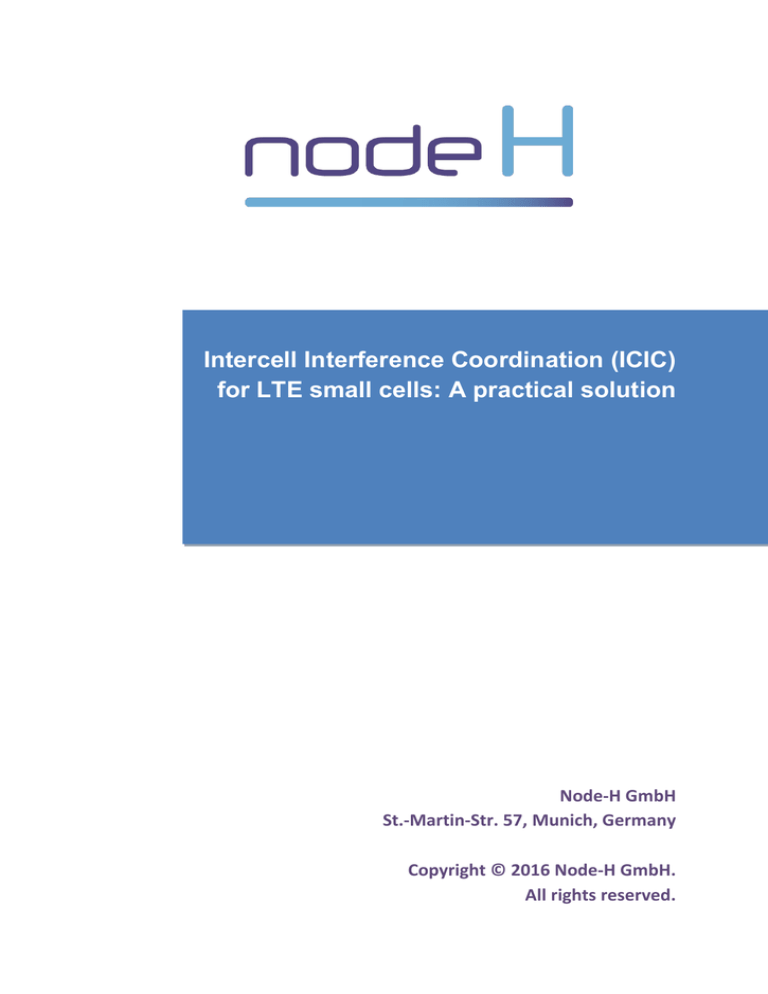
Intercell Interference Coordination (ICIC)
for LTE small cells: A practical solution
Node-H GmbH
St.-Martin-Str. 57, Munich, Germany
Copyright © 2016 Node-H GmbH.
All rights reserved.
Intercell Interference Coordination (ICIC) for LTE small cells: A practical solution
Contents
Executive summary ........................................................................................................ 2
Introduction ................................................................................................................... 3
Node-H ICIC solution: The method ................................................................................ 4
Node-H ICIC solution: The performance........................................................................ 5
Conclusion ..................................................................................................................... 6
Works Cited ................................................................................................................... 7
Page | 1
Intercell Interference Coordination (ICIC) for LTE small cells: A practical solution
Executive summary
Small cell networks are designed to exploit the spatial reuse of RF resources. This is
with the objective of maximizing the average bandwidth that a User Equipment (UE)
can receive. For this reason, network operators are constantly pursuing higher cell
densities, augmenting the spectral efficiency in the process but also raising the
interference levels under which these networks must operate. It is precisely in these
high interference scenarios that techniques like Intercell Interference Coordination
(ICIC) become fundamental to the correct functioning of the network.
ICIC reduces the interference level suffered by LTE users at the cell edge, thus
improving the signal-to-noise-ratio of their data channels and allowing the network
to operate in a cleaner RF environment. This is achieved by allowing individual cells
to closely coordinate their scheduling decisions with their immediate neighbouring
cells. This paper describes the ICIC solution from Node-H, which is based on a Soft
Frequency Reuse (SFR) approach supported by decentralized HeNB coordination over
the 3GPP-standard X2 interface. Node-H’s ICIC mechanism has been built to
guarantee the stability of the LTE air interface thanks to its tight coordination
between RRM and SON procedures. It accentuates inter-operability between HeNB
vendors thanks to the use of standard procedures and it provides the network
operator with flexible configuration options to define how ICIC shall operate.
Page | 2
Intercell Interference Coordination (ICIC) for LTE small cells: A practical solution
Introduction
Figure 1: Sample map of the average SINR in the PDSCH of a LTE small cells network without ICIC.
Small cell networks are deployed following a full frequency reuse approach. The
small coverage area of each cell enables a geographical reuse of licensed spectrum
much higher than that offered by the more traditional macro and picocells.
Consequently, the spectral efficiency per unit of area (measured in bps/Hz/m2)
offered by small cell networks is unparalleled and represents today the only
technology capable of satisfying the ever increasing data demand.
However, dense small cell deployments are not free of challenges [1]. From an
interference viewpoint, a full frequency reuse means that every cell acts as an
aggressor onto its neighbour cells. Whereas interference may not be critical for User
Equipments (UEs) near the cell centre, this is certainly not the case for the more
vulnerable cell-edge UEs. Indeed, despite the robustness and efficient coding
schemes that LTE has to offer, high density deployments of small cells can raise the
interference-plus-noise floor to unbearable levels at the cell edge (see Figure 1).
Fortunately, LTE’s physical layer in the radio interface provides a natural mechanism
for neighbour cells to coordinate the allocation of orthogonal resources to their UEs.
All that remains is for SON algorithms to apply such coordination mechanisms in a
manner that boosts the performance of cell-edge UEs.
The methodology described above is known as Intercell Interference Coordination
(ICIC) and it has long been considered as fundamental to guarantee the success of
LTE small-cells [2]. Although ICIC can diminish the data rates experienced by CellCentre (CC) UEs, such penalty is worth paying in exchange for the QoS boost that
Cell-Edge (CE) UEs obtain. The industry wide interest that ICIC raises is reflected in
the numerous institutions that have contributed to the standardization of ICIC
methods [3] [4].
Page | 3
Intercell Interference Coordination (ICIC) for LTE small cells: A practical solution
Node-H ICIC solution: The method
Figure 2: Sample PDSCH power allocation between two neighbour small cells.
The SON layer of Node-H’s LTE stack includes a decentralized ICIC algorithm that
allows HeNBs to cooperate in a manner that minimizes the interference levels at the
cell edges. The ICIC strategy of Node-H acts in the frequency and power domains,
thus enabling HeNBs to coordinate not only the spectrum chunks allocated to the
data channels of cell-edge UEs but also the transmit power with which these
channels are transmitted. Node-H’s solution is based on a Soft Frequency Reuse
(SFR) approach and is intended to improve the Signal-to-Interference-and-Noise
Ratio (SINR) of the Physical Downlink Shared Channel (PDSCH). This approach
reduces the HARQ retransmission rate of the PDSCH, thus effectively resulting in a
higher data rate.
The objectives described above are achieved in two stages: First, by exchanging radio
load information between neighbour HeNBs. And second, by selecting an optimal
radio resource allocation based on the exchanged information. During the first stage,
neighbour HeNBs exchange Relative Narrowband Tx Power (RNTP) information
within standard LOAD INFORMATION messages over the X2 interface [5].
Consequently, Node-H’s ICIC algorithm is interoperable with HeNBs from multiple
standards-compliant vendors. This information is then analysed by Node-H’s SON
layer, which uses it to select the cell-edge Resource Block Groups (RBGs) that would
cause the least interference onto its neighbour HeNBs, while also satisfying the
Quality of Service (QoS) guaranteed to cell-edge UEs.
Internally within each HeNB, all of the above requires a well-structured management
of the frequency and power resources allocated to cell-centre and cell-edge UEs.
Furthermore, timely signalling of RRC and MAC resources is necessary to guarantee
that the transitions between cell-edge and cell-centre are executed as smoothly as
possible. Node-H’s ICIC achieves this cross-layer objective by closely coordinating the
scheduler decisions with those taken at the SON level.
Node-H’s solution allows mobile network operators to provision HeNBs with a static
configuration for ICIC purposes. In addition, a self-configuration mode is also
available. The static configuration mode allows operators to specify which resource
blocks and which transmit power shall be used for cell-edge UEs. Such an approach
can be useful in enterprise deployments, wherein the HeNB locations and other
Page | 4
Intercell Interference Coordination (ICIC) for LTE small cells: A practical solution
parameters are planned beforehand. On the other hand, self-configuration of ICIC
resources is a must in residential environments, where the operator has no control
over HeNB locations or other random scenario changes. This allows HeNBs to take
ICIC decisions autonomously and adapt to the immediate needs of their
surroundings.
Node-H ICIC solution: The performance
Figure 3: Network architecture for ICIC performance evaluation
This section illustrates and quantifies the benefits that the ICIC technology from
Node-H can bring to a small-cells network. To measure this, Node-H’s approach to
ICIC has been evaluated in a shielded and cabled test-bed under different RF
conditions and configuration settings. Then numerical results of the data rates for
Cell-Centre (CC) UEs and Cell-Edge (CE) UEs have been obtained.
The capacity gain that ICIC provides depends strongly on the network topology and
on the geometry of each particular scenario. For illustration purposes, this paper
shows the performance of Node-H’s ICIC algorithm in a heavily interfered scenario
with two HeNBs (see Figure 3). Within this setup, the IP testing tool iperf [6] has been
used to monitor the end-to-end TCP capacity between UEs and a central server.
Table 1 summarises other relevant test parameters.
Table 1: Scenario characteristics for ICIC throughput test
Iperf
ICIC
Protocol
Simultaneous transfer to all UEs
Number of ICIC sub bands
PDSCH power boost for cell-edge UEs
TCP
yes
2
3 dB
ICIC is intended to improve data rates in situations of high-interference (e.g. hyper
dense co-channel networks). It is precisely in those scenarios, where the low SINR
levels diminish the throughput attainable by the UEs, that ICIC can bring the most
benefits to the overall network capacity. Performance figures for such a scenario are
illustrated in Figure 4. Here, the small cells are close together that they mutually
interfere with each other, therefore massively impacting the UEs’ experience. During
testing, the attenuation between UEs and HeNBs was kept constant. Activating ICIC
in this scenario, allowed both cells to immediately coordinate their power levels and
Page | 5
Intercell Interference Coordination (ICIC) for LTE small cells: A practical solution
resource allocations to cell-edge UEs. As a result, interference levels dropped for
both cell-edge and cell-centre UEs, resulting in a 28% gain for the cell edge UEs and a
net 15% gain of the overall network capacity.
Figure 4: Measured UE data rates in a heavily interfered network with two cells.
Conclusion
This paper has described Node-H’s ICIC mechanism, which is based on a Soft
Frequency Reuse (SFR) approach. This procedure schedules cell-edge UEs in the least
interfered Resource Blocks. In addition, it boosts the power with which data channels
are transmitted to cell-edge UEs. This methodology counteracts RF interference and
reduces capacity losses at the locations in which UEs are more vulnerable. In order to
maximize the effects of this interference avoidance in a network-wide manner,
neighbouring LTE cells use the standard X2 interface to dynamically coordinate their
frequency allocation decisions. These procedures would not be possible without
Node-H’s careful cross-layer design, which guarantees that SON and RRM decisions
are properly coordinated on every single subframe. The design paradigm pursued by
Node-H for a decentralized ICIC emphasizes inter-operability and 3GPP-compliant
procedures for a scalable and efficient LTE network deployment.
Contact Node-H at info@node-h.com to learn more about this and other Node-H
SON solutions for LTE small-cells.
Page | 6
Intercell Interference Coordination (ICIC) for LTE small cells: A practical solution
Works Cited
[1] D. Lopez-Perez, D. Ming, H. Claussen and A. Jafari, “Towards 1 Gbps/UE in Cellular
Systems: Understanding Ultra-Dense Small Cell Deployments,” IEEE
Communications Surveys & Tutorials, vol. 17, no. 4, pp. 2078-2101, 17 June 2015.
[2] D. Lopez, A. Valcarce, G. De La Roche and J. Zhang, “OFDMA femtocells: A
roadmap on interference avoidance,” IEEE Communications Magazine, vol. 47,
no. 9, pp. 41-48, 2009.
[3] ETSI, “TS 36.300; E-UTRA and E-UTRAN; Overall description; Stage 2; version
9.10.0 Release 9,” 2013.
[4] Small Cell Forum, “SON API for small cells,” 2015.
[5] 3GPP, “TS 36.423 X2 Application Protocol (X2AP) v11.6.0,” 2013.
[6] “iperf3: A TCP, UDP, and SCTP network bandwidth measurement tool,” [Online].
Available: https://github.com/esnet/iperf. [Accessed 15 12 2015].
Page | 7








